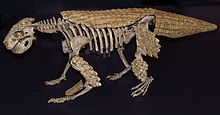Simosuchus clarki
|
Simosuchus Temporal range: Late Cretaceous, 70–66 Ma |
|
|---|---|
 |
|
| Display at the Royal Ontario Museum | |
| Scientific classification | |
| Kingdom: | Animalia |
| Phylum: | Chordata |
| Class: | Reptilia |
| Node: | †Ziphosuchia |
| Genus: |
†Simosuchus Buckley et al., 2000 |
| Species | |
|
|
Simosuchus (meaning "pug-nosed crocodile" in Greek, referring to the animal's blunt snout) is an extinct genus of notosuchian crocodylomorphs from the Late Cretaceous of Madagascar. It is named for its unusually short skull. Fully grown individuals were about 0.75 metres (2.5 ft) in length. The type species is Simosuchus clarki, found from the Maevarano Formation in Mahajanga Province.
The teeth of S. clarki were shaped like cloves (maple leaves), which coupled with its short and deep snout suggest it was not a carnivore like most other crocodylomorphs. In fact, these features have led many palaeontologists to consider it an herbivore.
Simosuchus was small, about 0.75 metres (2.5 ft) long based on the skeletons of mature individuals. In contrast to most other crocodyliforms, which have long, low skulls, Simosuchus has a distinctively short snout. The snout resembles that of a pug, giving the genus its name, which means "pug-nosed crocodile" in Greek. The shape of skulls differs considerably between specimens, with variation in ornamentation and bony projections. These differences may be indications of sexual dimorphism. The front portion of the skull, or preorbital area, is angled downwards. Simosuchus likely held its head so that the preorbital area was angled about 45° from horizontal. The teeth line the front of the jaws and are clove-shaped. At the back of the skull, the occipital condyle (which articulates with the neck vertebrae) is downturned. 45 autapomorphies, or features unique to Simosuchus, can be found in the skull alone.
...
Wikipedia
